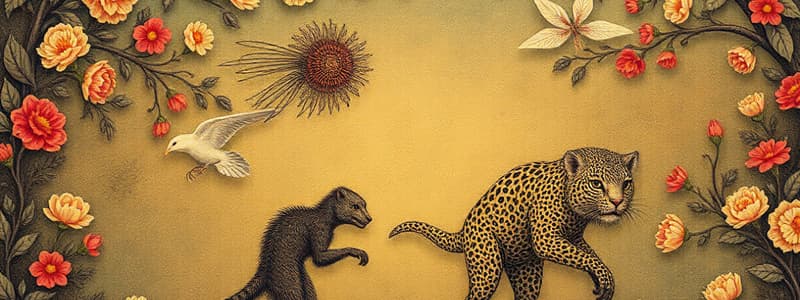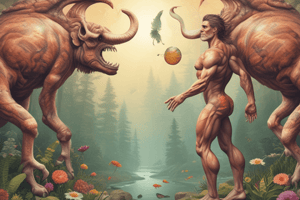Podcast
Questions and Answers
What is the main difference between microevolution and macroevolution?
What is the main difference between microevolution and macroevolution?
Which of the following is NOT a necessary condition for evolution by natural selection?
Which of the following is NOT a necessary condition for evolution by natural selection?
In the example of the peppered moth, what was the selective pressure that caused the shift in population towards the darker phenotype?
In the example of the peppered moth, what was the selective pressure that caused the shift in population towards the darker phenotype?
Why is it incorrect to say that evolution is "just a theory"?
Why is it incorrect to say that evolution is "just a theory"?
Signup and view all the answers
What is an example of a scientific law?
What is an example of a scientific law?
Signup and view all the answers
Which of the following statements BEST describes the role of natural selection in evolution?
Which of the following statements BEST describes the role of natural selection in evolution?
Signup and view all the answers
What does the statement "variation in survival/reproduction is non-random with respect to phenotype" mean in the context of evolution by natural selection?
What does the statement "variation in survival/reproduction is non-random with respect to phenotype" mean in the context of evolution by natural selection?
Signup and view all the answers
Why is the increase in average height of humans over time considered an example of evolution?
Why is the increase in average height of humans over time considered an example of evolution?
Signup and view all the answers
Flashcards
Evolution
Evolution
The change in species over generations through time.
Natural Selection
Natural Selection
A process where individuals better adapted to their environment survive and reproduce.
Peppered Moth Example
Peppered Moth Example
A classic case showing natural selection with moth color variation due to environmental changes.
Scientific Theory
Scientific Theory
Signup and view all the flashcards
Microevolution vs Macroevolution
Microevolution vs Macroevolution
Signup and view all the flashcards
Evolutionary Mechanisms
Evolutionary Mechanisms
Signup and view all the flashcards
Evolutionary History
Evolutionary History
Signup and view all the flashcards
Phenotypic Variation
Phenotypic Variation
Signup and view all the flashcards
Study Notes
Evolution
- Evolution is change over time within a population.
- Within an individual, this change is called development.
- Natural selection is one cause of evolution, but it's not the only one.
Peppered Moth Example
- Peppered moths occur in two color phases: light/peppered and dark.
- Initially, both phases are camouflaged against lichen-covered trees.
- Industrial pollution darkened tree bark, giving a survival advantage to dark moths.
Evolution as a Scientific Theory
- A scientific theory is a set of principles explaining natural phenomena, confirmed by observation and experiment.
- It's not a hunch or guess.
- Evolution by natural selection is mathematically inevitable.
Scientific Laws vs. Theories
- Scientific laws describe what happens, while a scientific theory explains why it happens.
- Evolution is a testable, unifying theory.
Evolutionary Biology Subfields
- Microevolution focuses on evolutionary mechanisms (ecological and genetic factors causing change).
- Macroevolution focuses on evolutionary history (common ancestry and phylogenetics).
Evolution by Natural Selection
- Four conditions for natural selection:
- Individuals within a population vary phenotypically.
- Phenotypic variation is heritable.
- Individuals vary in reproductive success.
- Variation in survival/reproduction is non-random relative to phenotype.
- These conditions lead to changes in population composition between generations.
Example: Human Height
- Improved diet and access to food led to taller individuals in 1997 compared to 1914.
Evolutionary Theory's Role
- Evolutionary theory provides a framework for understanding the natural world.
- It explains adaptations and biodiversity, with natural selection as a central concept.
Studying That Suits You
Use AI to generate personalized quizzes and flashcards to suit your learning preferences.
Description
This quiz explores the fundamental concepts of evolution, including natural selection, the example of the peppered moth, and the differences between scientific laws and theories. Gain insights into how evolutionary biology functions as a scientific discipline and its relevance in understanding diversity in populations.




